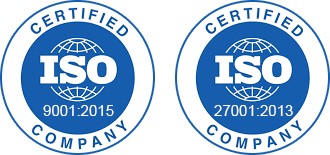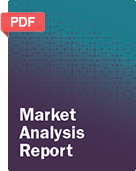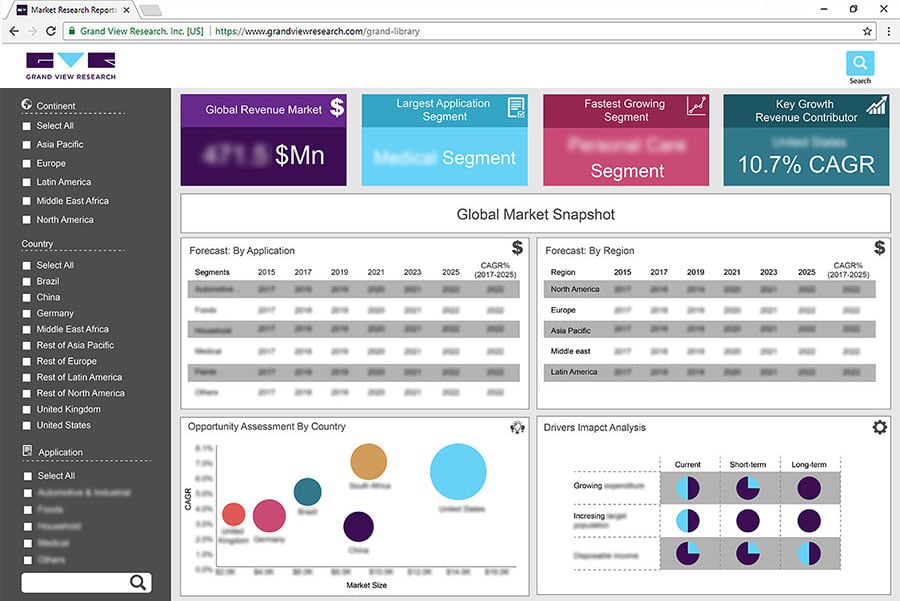- Home
- »
- Advanced Interior Materials
- »
-
Battery Cooling Plate Market Size And Share Report, 2030GVR Report cover
![Battery Cooling Plate Market Size, Share & Trends Report]()
Battery Cooling Plate Market Size, Share & Trends Analysis Report By Process (Direct Cooling, Indirect Cooling), By Application (BEV, PHEV), By Region, And Segment Forecasts, 2023 - 2030
- Report ID: GVR-4-68039-964-2
- Number of Report Pages: 83
- Format: PDF, Horizon Databook
- Historical Range: 2018 - 2021
- Forecast Period: 2023 - 2030
- Industry: Advanced Materials
Report Overview
The global battery cooling plate market size was estimated at USD 395.0 million in 2022 and is expected to grow at a compound annual growth rate (CAGR) of 37.4% from 2023 to 2030. The growth is expected to be favorably impacted by the green energy initiatives adopted by governments worldwide. The automotive industry has garnered significant attention, with ongoing research and development (R&D) for lightweight, energy-efficient, and sustainable material alternatives. The electric vehicle (EV) market has witnessed tremendous growth with the global consumer looking to switch to the usage of renewable energy sources. The governmental push toward aligning itself with the global decarbonization goals, in line with the 2021 Paris Agreement, has accelerated the production of EVs worldwide.
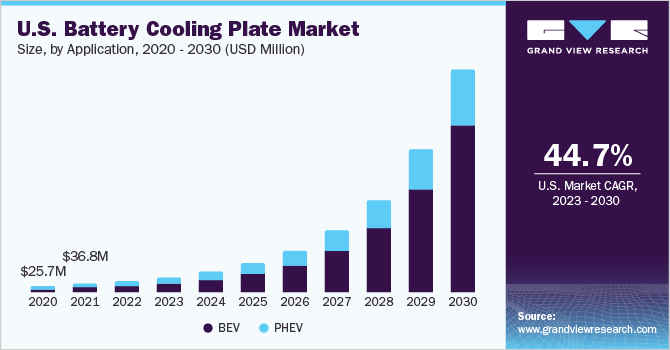
The U.S. is one of the key markets for the product, owing to the rising production of EVs and batteries. Several incentives have been provided for the sale and purchase of EVs in the country. Global EV production reached a record 10.3 million units in 2022. Three out of five top producers manufacture EVs in the U.S. and together held approximately 23.0% share of global production. For example, U.S.-based Tesla registered a 40% growth in its EV production from 2021 to 2022.
In line with the growing demand, Honda announced various initiatives to establish an EV hub in Ohio. In May 2023, as per the announcement, the Marysville Auto plant in Ohio will commence production in 2026. In addition, Toyota Motor announced an EV production facility in Kentucky in 2025. Thus, the demand for battery cooling plates is increasing due to the rapidly growing production of EVs.
The battery cooling plate manufacturing process involves aluminum ingots, high-pressure rollers, aluminum sheets, a stamping process, and an end product. As aluminum plays a vital role in the manufacturing process, the volatility in its prices and supply chain disruptions may present challenges for manufacturers. For instance, aluminum has an energy-intensive production. Hence, the surge in energy prices consequently affects the cost of manufacturing battery cooling plates.
Application Insights
Based on application, the battery EV (BEV) held the largest revenue share of over 55.0% in 2022. Rising investments toward expanding BEV production anticipating the demand is expected to positively influence segment growth. The plug-in hybrid EV (PHEV) segment is expected to register a CAGR of 29.3%, in terms of revenue, from 2023 to 2030. Various governmental initiatives to develop charging infrastructure in regions such as the Asia Pacific and North America are anticipated to drive growth in this segment.
Automotive manufacturers such as Volkswagen and BMW are driving the sales of PHEVs in developing markets. Battery cooling plates are imperative for EVs as they ensure no battery overheating when power is delivered while charging. Inefficient cooling can result in a thermal runaway that releases organic carbonates, which when mixed with air can cause fires. Hence, battery cooling plates offer temperature stability and prolong the life of battery cells.
Process Insights
Indirect cooling held a revenue share of over 76.0% in 2022 of the global market. Indirect cooling circulates a liquid coolant through a series of metal pipes and has the lowest temperature rise compared to all other types. Manufacturers such as Tesla and BMW utilize this method of cooling in their vehicles. The coolant used in this technology is the same as that of internal combustion engines, and hence this technology is widely available, reliable, and has further scope for improvement.
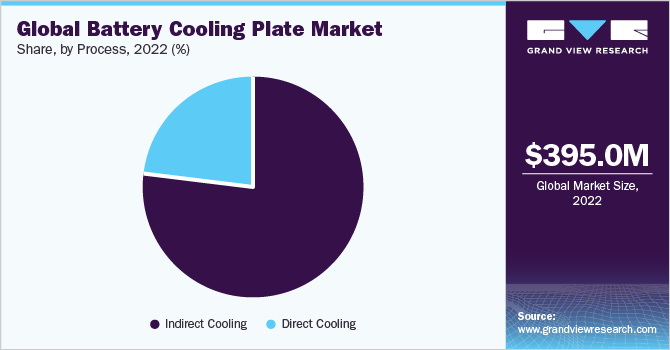
Direct cooling is anticipated to grow at a CAGR of 36.8% during the forecast period. The system configuration places the battery cells in direct contact with the coolant liquid. This technology is upcoming and is still in the R&D stage for the type of coolant that can be used. This technology requires the coolant must have low or no conductivity to achieve safe and optimum performance. Companies such as 3M, Solvay, and M&I Material have developed specific coolants that can be used for EV batteries.
Regional Insights
Asia Pacific held a global revenue share of over 50.0% in 2022. The presence of major EV manufacturers such as BYD, Tesla, Nissan, and General Motors in the region has led to the increased consumption of battery cooling plates. For instance, in February 2023, BYD announced plans to invest USD 1.2 billion in building a new factory in China for EV batteries. Such growth is anticipated to continue driving the market growth during the forecast period.
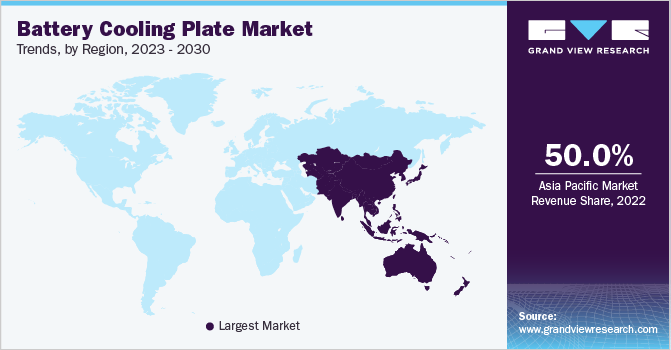
Europe held the second-largest revenue share of the global market in 2022. EV growth here is driven by the need to comply with stringent EU CO2 standards. This has led to an increasing number of automotive manufacturers committing to clean energy directives, converting their existing ICE lines to EVs, or setting up new EV production capacities.
North America is anticipated to register a CAGR of 44.2%, in terms of revenue, during the forecast period. Increasing investments in electric charging infrastructure such as Volkswagen Electrify America and Tesla superchargers have helped in making EVs increasingly attractive to buyers.
Key Companies & Market Share Insights
The market is highly competitive owing to various well-established players who constantly innovate to offer products with better battery cooling plate design specifications. The development of new cooling technologies has led to ongoing R&D and coordinated efforts by value chain participants are likely to continue to improve efficiency and safety.
The market competition is likely to advance further with the development of EV technology and full-scale commercialization of these vehicles in the global fleet system. The key vendors of the industry are already striving to build a presence in key vehicle manufacturing countries globally. Some of the prominent players in the global battery cooling plate market include:
-
Bespoke Composite Panels
-
Dana Limited
-
Estra Automotive
-
HELLA GmbH & Co. KGaA
-
KOHSAN Co., Ltd
-
MAHLE GmbH
-
Modine Manufacturing Company
-
Nippon Light Metals
-
Priatherm
-
SANHUA Automotive
Battery Cooling Plate Market Report Scope
Report Attribute
Details
Market size value in 2023
USD 500.2 million
Revenue forecast in 2030
USD 5.01 billion
Growth Rate
CAGR of 37.4% from 2023 to 2030
Base year for estimation
2022
Historical data
2018 - 2021
Forecast period
2023 - 2030
Report updated
August 2023
Quantitative units
Revenue in USD million, volume in kilotons, and CAGR from 2023 to 2030
Report coverage
Revenue & volume forecast, competitive landscape, growth factors, company profiles, and trends
Segments covered
Process, application, region
Regional scope
North America; Europe; Asia Pacific; Central & South America; Middle East & Africa
Country scope
U.S.; Germany; France; UK; Netherlands; China; Japan
Key companies profiled
Bespoke Composite Panels; Dana Limited; Estra Automotive; HELLA GmbH & Co.; KGaA; KOHSAN Co. Ltd; MAHLE GmbH; Modine Manufacturing Company; Nippon Light Metals; Priatherm; SANHUA Automotive
Customization scope
Free report customization (equivalent to up to 8 analysts working days) with purchase. Addition or alteration to country, regional & segment scope.
Pricing and purchase options
Avail customized purchase options to meet your exact research needs. Explore purchase options
Global Battery Cooling Plate Market Report Segmentation
This report forecasts revenue and volume growth at the global, regional, and country levels and provides an analysis of the latest industry trends in each of the sub-segments from 2018 to 2030. For this study, Grand View Research has segmented the global battery cooling plate market report based on process, application, and region:
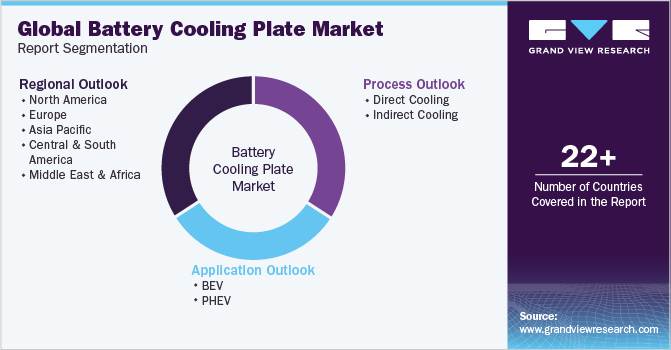
-
Process Outlook (Volume, Kilotons; Revenue, USD Million, 2018 - 2030)
-
Direct Cooling
-
Indirect Cooling
-
-
Application Outlook (Volume, Kilotons; Revenue, USD Million, 2018 - 2030)
-
BEV
-
PHEV
-
-
Regional Outlook (Volume, Kilotons; Revenue, USD Million, 2018 - 2030)
-
North America
-
U.S.
-
-
Europe
-
Germany
-
France
-
UK
-
Netherlands
-
-
Asia Pacific
-
China
-
Japan
-
-
Central & South America
-
Middle East & Africa
-
Frequently Asked Questions About This Report
b. The global battery cooling plate market was estimated at USD 395.0 million in 2022 and is expected to reach USD 500.2 million in 2022.
b. The battery cooling plate market is expected to grow at a compound annual growth rate of 37.4% from 2023 to 2030 to reach USD 5.01 billion by 2030.
b. BEV was the key application segment of the global market with a revenue share of more than 55.0% in 2022.
b. Some of the key players operating in the battery cooling plate market are Bespoke Composite Panels, Dana Limited, Estra Automotive, KOHSAN Co., Ltd, MAHLE GmbH, Modine Manufacturing Company, Nippon Light Metals, Priatherm, and SANHUA Automotive, among others.
b. Increasing demand for EVs as a result of the ongoing decarbonization and green energy initiative is anticipated to drive the growth of the battery cooling plate market over the forecast period.
Share this report with your colleague or friend.
![gvr icn]()
NEED A CUSTOM REPORT?
We can customize every report - free of charge - including purchasing stand-alone sections or country-level reports, as well as offer affordable discounts for start-ups & universities. Contact us now
![Certified Icon]()
We are GDPR and CCPA compliant! Your transaction & personal information is safe and secure. For more details, please read our privacy policy.
We are committed towards customer satisfaction, and quality service.
"The quality of research they have done for us has been excellent."
